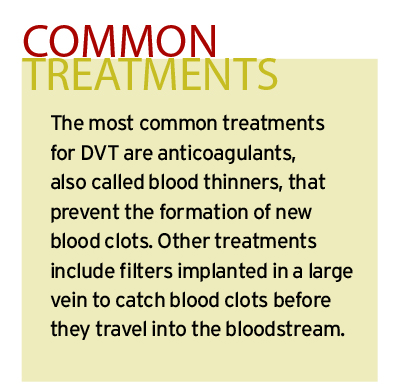Clotting risks

Deep vein thrombosis can be life-threatening
Deep vein thrombosis (DVT) is a blood clot that forms in the larger veins of the body due to slow blood flow, blood vessel damage or increased tendency to clot.
When we cut our skin, the blood clotting process creates a scab. When that process begins inside our bodies—typically in the blood vessels in our legs—the resulting clot can break off and travel through the bloodstream to an artery in the lungs, blocking blood flow and causing life-threatening complications such as a pulmonary embolism (PE).
According to the Centers for Disease Control and Prevention, up to 100,000 Americans die each year from deep vein thrombosis/PE. That’s more than deaths from breast cancer, motor vehicle accidents and HIV combined.

Although DVT can occur at any age, it is more common in people over 50. Risk factors for this condition are a family history of DVT, cancer, undergoing hormone therapy or taking birth control pills, pregnancy, injury to a deep vein caused by surgery or trauma, having a catheter placed in a vein, prolonged bedrest that leads to slow blood flow in deep veins, obesity and smoking.
Some people may not realize they have DVT until they are affected by a PE, which leads to low blood oxygen levels, lung damage, heart failure and death. Signs of this condition are sudden shortness of breath, chest pain, coughing up blood, dizziness, rapid pulse and fever. If you have any of these symptoms, especially if you are at risk for DVT, seek immediate medical attention.
If you are at risk for DVT or pulmonary embolism, it is important to take preventive measures. Have regular medical checkups, take your prescribed medicine, and exercise regularly—especially lower leg muscles—after surgery and during long trips.
Nathan Orr, MD, is a vascular surgeon at UK HealthCare.

